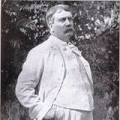
Daniel H. Burnham (1846 – 1912)
Daniel Burnham designed some of the world’s earliest skyscrapers and helped create the first complete plan for controlling urban growth. Drawing upon the City Beautiful movement, Daniel Burnham proposed a plan for Chicago that included extensive parkland and laid the foundation for modern theories of urban design.
Since 1917, Burnham’s firm has been practicing architecture under the name Graham, Anderson, Probst & White.
Notable Buildings:
1890: With Charles Atwood, the Reliance Building, Chicago, Illinois. Expanded to 14 floors in 1894
1891: With John Root, the Art Institute of Chicago
1902: the Flatiron Building, formerly known as the Fuller building, New York, New York
1903: Pennsylvanian Union Train Station, Pittsburgh, Pennsylvania
1907: Union Station, Washington DC
1912: With John M. Carrere and Arnold R. Brunner, the Cuyahoga County Courthouse, Cleveland, Ohio
Urban Design:
1893: Served as chief coordinating architect for the 1893 World Columbian Exposition, creating a vast, orderly Beaux-Arts plan for the city
1904: Plan for Baguio for the U.S. Philippine Commission
1905: Plan for Manila for the U.S. Philippine Commission
1909: Co-authored the Plan of Chicago, which controlled urban growth and provided for extensive parkland
Famous Quote:
“Make no little plans; they have no magic to stir men’s blood and probably themselves will not be realized. Make big plans; aim high in hope and work, remembering that a noble, logical diagram once recorded will not die, but long after we are gone be a living thing, asserting itself with ever-growing insistence. Remember that our sons and our grandsons are going to do things that would stagger us. Let your watchword be order and your beacon beauty.”